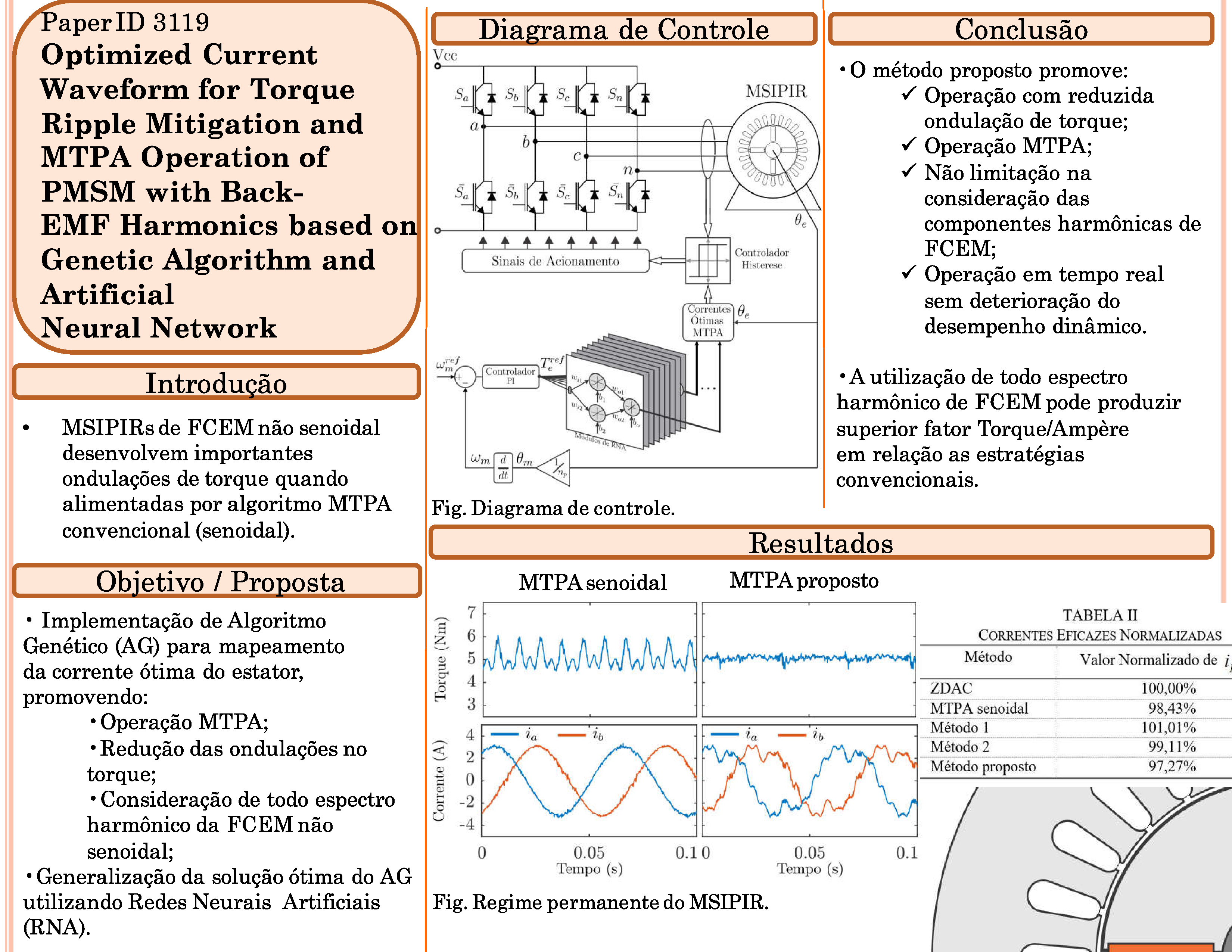Optimized Current Waveform for Torque Ripple Mitigation and MTPA Operation of PMSM with Back EMF Harmonics based on Genetic Algorithm and Artificial Neural Network
Keywords:
Artificial neural network (ANN), genetic algorithm (GA), interior permanent magnet synchronous motor (IPMSM), maximum torque per Ampère (MTPA), nonsinusoidal back-EMF, torque rippleAbstract
Interior permanent magnet synchronous motors (IPMSMs) with nonsinusoidal flux develop undesirable torque ripple under conventional control strategies, leading to vibration and increase of mechanical stress. To overcome this problem, active torque ripple compensation based on harmonic stator current injection is widely investigated in the literature. However, the combination of the torque ripple minimization strategy with the maximum torque per Ampère (MTPA) operation is a challenge to the field. In this paper, a control strategy based on genetic algorithm (GA) and artificial neural network (ANN) is proposed to achieve low torque ripple with MTPA operation of a three-phase IPMSM with significant magnitude of zero sequence back-electromotive force (back-EMF) component. Investigations have found that the consideration of back-EMF zero sequence in torque prodution can increase the torque per Ampère ratio. Further, the results shows that the proposed strategy effectively reduces the torque ripple in real time operation, including steady state and transient torque performances.
Downloads
References
M. Melfi, S. Evon, and R. McElveen, “Induction versus permanente magnet motors,” IEEE Ind. Appl. Mag., vol. 15, no. 6, pp. 28–35, nov 2009.
Ching-Tsai Pan and Shinn-Ming Sue, “A linear maximum torque per ampere control for IPMSM drives considering magnetic saturation,” in 30th Annu. Conf. IEEE Ind. Electron. Soc. 2004. IECON 2004, vol. 3, no. 2. IEEE, 2005, pp. 2712–2717.
Z. Q. Zhu and J. H. Leong, “Analysis and mitigation of torsional vibration of PM brushless AC/DC drives with direct torque controller,” IEEE Trans. Ind. Appl., vol. 48, no. 4, pp. 1296–1306, 2012.
D. Flieller, N. K. Nguyen, P. Wira, G. Sturtzer, D. O. Abdeslam, and J. Merckle, “A Self-Learning Solution for Torque Ripple Reduction for Nonsinusoidal Permanent-Magnet Motor Drives Based on Artificial Neural Networks, “IEEE Trans. Ind. Electron., vol. 61, no. 2, pp. 655– 666, feb 2014.
D. Hanselman, Brushless Permanent Magnet Motor Design Second Edition. Magna Psysics Publishing, 2006, vol. 2.
P. Mattavelli, L. Tubiana, and M. Zigliotto, “Torque-Ripple Reduction in PM Synchronous Motor Drives Using Repetitive Current Control,” IEEE Trans. Power Electron., vol. 20, no. 6, pp. 1423–1431, nov 2005.
S. J. Park, H. W. Park, M. H. Lee, and F. Harashima, “A new appro- ach for minimum-torque-ripple maximum-efficiency control of BLDC motor,” IEEE Trans. Ind. Electron., vol. 47, no. 1, pp. 109–114, 2000.
G. Buja, M. Bertoluzzo, and R. K. Keshri, “Torque Ripple-Free Ope- ration of PM BLDC Drives With Petal-Wave Current Supply,” IEEE Trans. Ind. Electron., vol. 62, no. 7, pp. 4034–4043, jul 2015.
C. Lai, G. Feng, K. Lakshmi Varaha Iyer, K. Mukherjee, and N. C. Kar, “Genetic Algorithm-Based Current Optimization for Torque Ripple Reduction of Interior PMSMs,” IEEE Trans. Ind. Appl., vol. 53, no. 5, pp. 4493–4503, 2017.
A. Goedtel, I. Nunes Da Silva, P. Jose Amaral Serni, M. Suetake, C. Franscisco Do Nascimento, and S. Augusto Oliveira Da Silva, “Speed estimation for induction motor using neural networks method,” IEEE Lat. Am. Trans., vol. 11, no. 2, pp. 768–778, 2013.
F. Lima, W. Kaiser, I. Nunes Da Silva, and A. A. De Oliveira, “Speed neuro-fuzzy estimator applied to sensorless induction motor control,” IEEE Lat. Am. Trans., vol. 10, no. 5, pp. 2065–2073, 2012.
J. Yu, “A hybrid feature selection scheme and self-organizing map model for machine health assessment,” Appl. Soft Comput. J., vol. 11, no. 5, pp. 4041–4054, 2011.
E. Germen, M. Bas¸aran, and M. Fidan, “Sound based induction motor fault diagnosis using Kohonen self-organizing map,” Mech. Syst. Signal Process., vol. 46, no. 1, pp. 45–58, 2014.
W. S. Gongora, A. Goedtel, S. A. Da Silva, and C. L. Graciola, “Neural Approach to Fault Detection in Three-phase Induction Motors,” IEEE Lat. Am. Trans., vol. 14, no. 3, pp. 1279–1288, 2016.
J. Kern, M. Jamett, C. Urrea, and H. Torres, “Development of a neural controller applied in a 5 DOF robot redundant,” IEEE Lat. Am. Trans., vol. 12, no. 2, pp. 98–106, 2014.
N. Nakao and K. Akatsu, “Torque ripple suppression of permanent magnet synchronous motors considering total loss reduction,” 2013 IEEE Energy Convers. Congr. Expo. ECCE 2013, pp. 3880–3887, 2013.
P. C. Krause, O. Wasynczuk, and S. D. Sudhoff, Analysis of Electric Machinery and Drive Systems. Wiley-IEEE Press, 2002.
L. Wang, A. H. C. Ng, and K. Deb, Multi-objective Evolutionary Optimisation for Product Design and Manufacturing, L. Wang, A. H. C. Ng, and K. Deb, Eds. London: Springer London, 2011.
R. Ni, D. Xu, G. Wang, L. Ding, G. Zhang, and L. Qu, “Maximum Efficiency per Ampere Control of Permanent-Magnet Synchronous Ma-chines,” IEEE Trans. Ind. Electron., vol. 62, no. 4, pp. 2135–2143, 2015.
Kshirsagar, P., & Krishnan, R. (2012). High-Efficiency Current Excitation Strategy for Variable-Speed Nonsinusoidal Back-EMF PMSM Machines. IEEE Transactions on Industry Applications, 48(6), 1875–1889. 10.1109/TIA.2012.2225814
C. L. Baratieri, “Contribuições ao Controle do Motor Síncrono de Imã Permanente com FCEM não Senoidal,” Ph.D. dissertation, Federal University of Santa Maria, Santa Maria, Rio Grande do Sul, 2015.
Cybenko, G. (1989) "Approximations by superpositions of sigmoidal functions", Mathematics of Control, Signals, and Systems, 2(4), 303–314. doi:10.1007/BF02551274.


